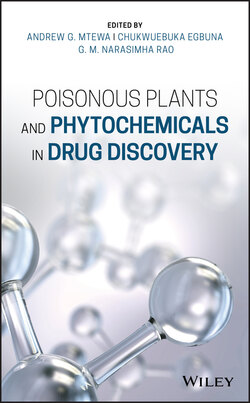Читать книгу Poisonous Plants and Phytochemicals in Drug Discovery - Группа авторов - Страница 31
2.1 Introduction
ОглавлениеPhytotoxins are basically toxic secondary metabolites that are found in plants. They largely have low molecular weight and are capable of deranging vital plant physiology and plant cell activities and/or causing the death of a plant at less than 10 mM concentrations [1]. There are hundreds of such substances in a single plant in addition to non‐toxic chemicals, which demonstrates the complexity of phytochemical systems. Phytotoxins can be synthesized by the plants themselves [2], by endophytes (bacteria, fungi, etc.) in the plants [3], and also by phytophagous insects [1].
Phytotoxins can be categorized into two broad groups: those that have an effect on plant systems and physiology and those that have an effect on animals and humans. Those that affect plant systems and physiology are the ones that enjoy the most scientific limelight; they are most commonly discussed in the field of phytotoxins with a focus on the quality of plant life. There is a relatively narrower discussion on phytotoxins that the plant produces with a focus on elements foreign to and outside the plants themselves, such as predators.
Some of the existing phytotoxins are produced by plants for defense purposes against predators, such as insects, microorganisms, and higher animals. At other times, they are produced in response to infestation by environmental and physical stress, such as extreme drought, humidity, and confinement, e.g. growing under a huge rock.
Although phytotoxins are largely known to show adverse effects on plants such as necroses, chloroses, general suppression of growth, wilting, and spotting of aerial portions [1], they may also produce toxins and other metabolites that are beneficial to drug discovery.
Apart from plant health, phytotoxins have been established as playing a significant role in human health. It is therefore important to categorically detail their important identity characteristics to make it easy to understand how they can be used or controlled when it comes to drug development. In this way, their molecular clustering can more efficiently and conveniently lead to the identification of potential drug scaffolds. This chapter discusses the categorization of phytotoxins within the two broad distinctions stated earlier and relates the same to the risks and benefits that these toxins have for disease management and prevention.
